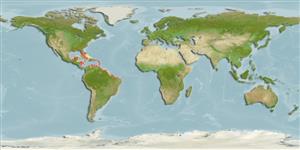Common names from other countries
Environment: milieu / climate zone / depth range / distribution range
Ökologie
seewasser; brackwasser riff-verbunden; ozeanodrom; tiefenbereich 0 - 5 m (Ref. 5227). Subtropical; 45°N - 40°S, 98°W - 32°W
Western Atlantic: south Florida (USA), through the Caribbean and along the coasts of Central and South America to Uruguay.
Length at first maturity / Size / Gewicht / Alter
Maturity: Lm 18.9 range ? - ? cm
Max length : 30.0 cm TL Männchen/unbestimmt; (Ref. 5217); common length : 20.0 cm SL Männchen/unbestimmt; (Ref. 3723)
Body elongate; lower jaw very prolonged; upper jaw short, triangular, and scaly; lower branch of first gill arch with 29 to 38 gill rakers; fins lacking spines; pectoral fins not very long; caudal fin emarginate or slightly forked; anal fin with 15 to 18 rays; back greenish, with 3 narrow, dark, bars; flanks and belly silvery white; fleshy border of lower jaw red; caudal fin light colored with dark tips (Ref. 55763).
An inshore, surface-dwelling species forming sizeable schools, frequently entering estuaries (Ref. 3723). Uncommon over reefs (Ref. 9710). Omnivorous, feeds on algae and other small animals (Ref. 3723). Caught with 'mandinga' nets in Venezuela, often using lights (Ref. 3723). Edible but not really appreciated (Ref. 3723).
Life cycle and mating behavior
Geschlechtsreife | Fortpflanzung | Ablaichen | Eier | Fecundity | Larven
Robins, C.R. and G.C. Ray, 1986. A field guide to Atlantic coast fishes of North America. Houghton Mifflin Company, Boston, U.S.A. 354 p. (Ref. 7251)
IUCN Rote Liste Status (Ref. 130435)
CITES (Ref. 128078)
Not Evaluated
Bedrohung für Menschen
Reports of ciguatera poisoning (Ref. 30911)
Nutzung durch Menschen
Fischereien: weniger kommerziell; Köder: usually
Mehr Information
ReferenzenAquakulturAquakultur ProfilZuchtlinienGenetikElectrophoresesVererbbarkeitKrankheitenVerarbeitungMass conversion
PartnerBilderStamps, Coins Misc.LauteCiguateraGeschwindigkeitSchwimmstilKiemenoberflächeOtolithsGehirngrößeSehfähigkeit
Tools
Zusatzinformationen
Download XML
Internet Quellen
Estimates based on models
Preferred temperature (Ref.
115969): 22.9 - 28.1, mean 27.3 (based on 769 cells).
Phylogenetic diversity index (Ref.
82804): PD
50 = 0.5000 [Uniqueness, from 0.5 = low to 2.0 = high].
Bayesian length-weight: a=0.00234 (0.00179 - 0.00307), b=3.09 (3.03 - 3.15), in cm Total Length, based on LWR estimates for this species (Ref.
93245).
Trophic level (Ref.
69278): 2.0 ±0.0 se; based on diet studies.
Widerstandsfähigkeit (Ref.
120179): hoch, Verdopplung der Population dauert weniger als 15 Monate. (Preliminary K or Fecundity.).
Fishing Vulnerability (Ref.
59153): Low vulnerability (15 of 100).
